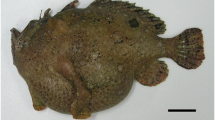Abstract
The present study provides morphological and molecular data on the Indian frogfish, Antennarius indicus, recorded from the Iranian waters of the northern Gulf of Oman. A single specimen was captured from a coral reef at ca. 5 m depth in the Chabahar Bay. Species identification was performed based on external morphology and sequence analysis of 16S and COI mitochondrial genes. Our results support the notion that the type of illicium is one of the most important features in distinguishing species within the genus Antennarius. However, using meristic characters such as counts of pectoral fin rays in the delimitation of Antennarius indicus should be taken with caution as they may only represent the existence of different populations. This record from Iran, which adds a brand new species to the Iranian marine fish fauna, fills the gap in the distribution range of the species from westernmost Persian Gulf (Iraq) to the easternmost Gulf of Oman (Pakistan) and also confirms the presence of the species in the northern Gulf of Oman.




Similar content being viewed by others
References
Akaike H (1974) A new look at the statistical model identification. IEEE Trans Autom Control 19(6):716–723
Al-Jufaili SM, Hermosa G, Al-Shuaily SS, Al Mujaini A (2010) Oman fish biodiversity. Mar Sci 21(1):3–51
Arnold RJ, Pietsch TW (2012) Evolutionary history of frogfishes (Teleostei: Lophiiformes: Antennariidae): a molecular approach. Mol Phylogenet Evol 62(1):117–129
Delfieh P, Zohrehbakhsh E, Owfi F, Kazemian M, Delfieh P (2011) The overview study of Engraulididae and Pristigasteridae, two families of Clupeiforms in the Persian Gulf and Oman Sea. J Mar Biol 3(1):41–52 In Persian
Folmer O, Black M, Hoeh W, Lutz R, Vrijenhoek R (1994) DNA primers for amplification of mitochondrial cytochrome c oxidase subunit I from diverse metazoan invertebrates. Mol. Mar. Biol. Biotechnol. 3:294–299
Froese R, Pauly D [Eds] (2018) FishBase, http://www.fshbase.org [Accessed on 08/06/2018]
Gell FR, Whittington MW (2002) Diversity of fishes in seagrass beds in the Quirimba archipelago, northern Mozambique. Mar Freshw Res 53(2):115–121
Ghanbarifardi M, Malek M (2008) Permanent intertidal fish from the Persian Gulf and Gulf of Oman, Iran. Iran J Anim Biosyst 3(1):1-14
Global Biodiversity Information Facility (GBIF) (2018) Antennarius indicus Schultz, 1964 in GBIF secretariat. GBIF backbone taxonomy, Checklist dataset https://doi.org/10.15468/39omei accessed via GBIF.org on 2018-10-07
Han SH, Kim JS, Song CB (2017) The first record of a frogfish, Fowlerichthys scriptissimus (Antennariidae, Lophiiformes), from Korea. Fish Aquat Sci 20(1):2
Huelsenbeck JP, Ronquist F (2001) MRBAYES: Bayesian inference of phylogenetic trees. Bioinformatics 17(8):754–755
Jawad LA, Al-Mamry J (2009) First record of Antennarius coccineus from the Gulf of Oman and second record of Antennarius indicus from the Arabian Sea coast of Oman. Mar Biodivers Rec 2:1-3
Jawad LA, Hussain S (2014) First record of Antennarius indicus (Pisces: Batrachoidiformes: Antennaridae), Equulites elongatus (Pisces: Perciformes: Leiognathidae) and second record of Cheilinus lunulatus (Pisces: Perciformes: Labridae) from the marine waters of Iraq. International Journal of Marine Science 4(40):1–5
Katoh K, Rozewicki J, Yamada KD (2017) MAFFT online service: multiple sequence alignment, interactive sequence choice and visualization. Brief Bioinform bbx108, https://doi.org/10.1093/bib/bbx108
Lieske E, Myers R (1994) Coral reef fishes Caribbean, Indian Ocean and Pacific Ocean including the Red Sea. Princeton University Press, Princeton, NJ
Mahapatro D (2017) Study of macrobenthos of Chilika Lake -a coastal lagoon on East Coast of India. Ph.D. thesis. Berhampur University, Berhampur-760007: pp. 256
Mahmoodzadeh A (2015) Determination of biodiversity and spatial and temporal distribution pattern of demersal fishes in the Oman Sea. Islamic Azad University, Science and Research Branch, Tehran
Manilo LG, Bogorodsky SV (2003) Taxonomic composition, diversity and distribution of coastal fishes of the Arabian Sea. J Ichthyol 43(1):75–149
Maslenikov K (2016) UWFC ichthyology collection. University of Washington Burke Museum. Occurrence dataset https://doi.org/10.15468/vvp7gr accessed via GBIF.org on 2019-01-19
Nelson JS, Grande TC, Wilson, MV (2016) Fishes of the World. John Wiley & Sons
OBIS (2018) [Distribution records of Antennarius indicus (Schultz, 1964)], (Available: Ocean Biogeographic Information System. Intergovernmental Oceanographic Commission of UNESCO. www.iobis.org. Accessed: 2018-10-07)
Palumbi SR (1996) Nucleic acids II: the polymerase chain reaction. In: Molecular systematics, (Eds DM Hillis, C. Moritz and BK Mable.) pp 205–247
Pietsch TW (1981) The osteology and relationships of the anglerfish genus Tetrabrachium with comments on lophiiform classification. Fishery Bulletin United States, National Marine Fisheries Service
Pietsch TW (1984) The genera of frogfishes (family Antennariidae). Copeia 1984(1):27–44
Pietsch TW, Grobecker DB (1987) Frogfishes of the world: systematics, zoogeography, and behavioral ecology. Stanford University Press, Redwood City, CA
Posada D, Crandall KA (1998) Modeltest: testing the model of DNA substitution. Bioinformatics (Oxford, England) 14(9):817–818
Psomadakis PN (2015) Field identification guide to the living marine resources of Pakistan. FAO Species Identifcation Guide for Fishery Purposes. FAO, Rome.
Randall JE (1995) Coastal fishes of Oman. University of Hawaii Press, Honolulu, Hawaii
Sambrook J, Fritsch EF, Maniatis T (1989) Molecular cloning: a laboratory manual. Cold spring harbor laboratory press, Cold Spring Harbor, New York
Schultz LP (1964) Three new species of frogfishes from the Indian and pacific oceans with notes on other species (family Antennariidae). Proceedings of the United States National Museum
Stamatakis A (2006) RAxML-VI-HPC: maximum likelihood-based phylogenetic analyses with thousands of taxa and mixed models. Bioinformatics 22(21):2688–2690
Valinassab T, Daryanabard R, Dehghani R, Pierce GJ (2006) Abundance of demersal fish resources in the Persian Gulf and Oman Sea. J Mar Biol Assoc UK 86(6):1455–1462
Acknowledgements
The authors wish to thank the anonymous referees for their constructive comments on an earlier version of this paper.
Author information
Authors and Affiliations
Corresponding author
Ethics declarations
Conflict of Interest
Authors have no conflict of interest to declare.
Additional information
Publisher’s Note
Springer Nature remains neutral with regard to jurisdictional claims in published maps and institutional affiliations.
Electronic Supplementary Material
ESM 1
(DOCX 16 kb)
Rights and permissions
About this article
Cite this article
Oladi, M., Saberi-Pirooz, R., Ahmadzadeh, F. et al. Further Documentation of the Indian Frogfish, Antennarius indicus (Teleostei: Lophiiformes), from the ROPME Sea Area; a Molecular and Morphological Approach. Thalassas 35, 503–509 (2019). https://doi.org/10.1007/s41208-019-00147-1
Received:
Revised:
Published:
Issue Date:
DOI: https://doi.org/10.1007/s41208-019-00147-1




